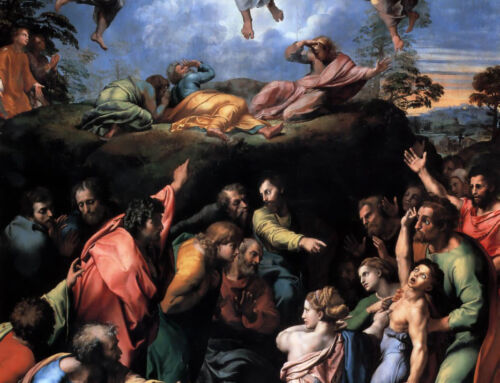On Good Friday we will hear John’s account of the passion and death of Jesus. John includes one small detail in his account of the Passion which provides a profound understanding of Jesus’s identity and the gravity of His crucifixion. At the beginning of the Gospel reading Judas and his search party arrive at the garden across the Kidron Valley where they find Jesus. Jesus, knowing what is going to happen, asks them first “whom are you looking for?” they respond, “Jesus the Nazorean.” To which Jesus responds with the short but immensely rich phrase “I AM” (Jn 18:5). Then something unusual happens. Something which is easy to overlook because of its strangeness and its seeming triviality. “When he said to them, ‘I AM,’ they turned away and fell to the ground” (Jn 18:6). Why?
Jesus uses the phrase “I am” not in the way I would say “I am a teacher” but with all of the theological and philosophical depth of the name God gives Himself in the book of Exodus: “I AM WHO AM” (Ex 3:14). Ask a 6th grader at St. Benedict Classical Academy and they will tell you this is so much more than a name, while at the same time intentionally so much less. God both refuses to be categorized by human language while giving us a profound insight into His relationship with the world. Translated by the early Church Fathers and Scholastic Theologians alike into the Latin Ipsum Esse Subsistens, the name God gives Himself in Exodus takes on the sense of God being “that which is and cannot not be.” In other words, God is the ground of being itself, the reason there is anything at all, and the thing without which there would be nothing.
And so when Judas’s search party falls to the ground at the name of “I AM” they are reacting appropriately to the name of God. Any first century Jew would have internalized this name and the power it bore. Moses hides his face, afraid to look at God (Ex 3:6), Jacob is amazed when his life is “spared” after seeing God face to face (Gen 32:30), all across the Old Testament it is made clear that one does not casually glimpse God.
And so, what are we meant to take away from this small portion of the Gospel? Two things I think. First, this line underscores the reality of God made man in Jesus Christ. That, in Jesus Christ, it is not the best human or the holiest human choosing selfless love so as to provide us with an example of how to live. Instead, it is this and so much more. In Jesus it is the ground of being Himself which chooses you. Dies for you. And has you and you alone on His mind when Judas’s band approaches in the garden. Not some abstract notion of humanity that needs saving. But you. And it is for you that “I AM” goes to die, so that with Him you might live.
And second, the God we believe in is not foreign to our suffering. God is not distant and removed from the reality of evil in our world. Instead, in Jesus, God chooses to become intimately present to this evil. Betrayal, murder, injustice, suffering, loneliness; all immediately present to this “suffering servant” (Is 52:13). In my capacity as a youth minister this is the primary objection our young people have to God, “I don’t think the world would be as it is if there really was a God who loved us.” But when Jesus says “I AM” He says to us that He is “that which is and cannot not be,” “ipsum esse subsistens” and all that comes with it. But He also answers the question which cries out from every suffering heart, “are you still there God?” even in my suffering, in my loss, in my pain are you still there?
“I AM.”
AUTHOR: Zach Morris, Grade 6 Teacher








